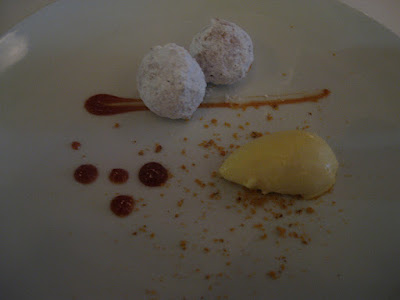The French Laundry has a tough job these days. Its reputation is so established, legion of fans so large, and margin for error so non-existent that it’s an easy target. Food is a deeply personal thing. A restaurant can be even more so. Chefs, like writers, put forward an intimate, creative side of themselves for public judgment. If that’s the case, then Thomas Keller is the cooking equivalent to Phil Jackson coaching in the NBA finals. He just doesn’t lose. He takes what he’s given, adapts to it, gets the absolute most out of it, and leaves you astonished.
The French Laundry is a restaurant that doesn’t let you down. It is the place that encompasses the evolution and ascendancy of restaurants in the United States over the past forty years. It harnesses the power of Alice Waters’ emphasis on fresh, seasonal, and local ingredients, couples it with the very best in formal service with an influence of American casualness, and incorporates an elegant dedication to classicism for the food and décor. In short, the French Laundry is the restaurant that tries — and succeeds — at pleasing everyone. Or at least coming close.
Two recent trips to the French Laundry confirm this is the best restaurant in the country. Period. But to bestow such a sweeping superlative on the place undermines the true pleasure of the experience. Make no mistake, though, a meal here is a pure luxury. At $240 (service included) for a nine-course tasting or nine-course vegetarian menu, you’ll be lucky to make it our for less than $500 per person once wine comes into play. But it is the meal, if you have deep-seated passion for food, you owe to yourself at least once. Give up your Starbucks or Chick-Fil-A habit for a year. You won’t regret it.
The first impression of the restaurant is how unassuming it is. You won’t notice it if you just drive down Washington Street in Yountville. Inside, the restored building is magnificent. Refined rusticity might have been invented here. The tables reflect the restaurant’s name: crisp, white linens; the napkin secured to white plates, shimmering from the soft light given off by wall sconces, with an old fashioned laundry pin.
For an establishment that attracts such zealous lovers of food, the atmosphere is so relaxed and unhurried, you can’t help but feel at ease. It’s a remarkable feat, really, considering the ratio of servers to diners. With room for about sixty customers, the two-story dining room also accommodates seemingly forty staff. The remarkable thing is you can’t really tell how many servers there are because they are simultaneously ubiquitous and invisible. To create a pleasant, quiet environment while lavishing each table with attention is a remarkable feat. The only potential issue in the dining can be temperature: in the summer it can be stuffy, compounded by the jacket requirement for men.
The starter rarely changes: two amuse bouche, the cheese gougeres and salmon tartare with red onion crème fraiche in a sesame tuile. This is an important first step. The gougeres show remarkable execution of the pastry, while allowing the gruyere to shine through clearly but not overwhelmingly. The salmon “ice cream cone” is legendary for good reason. It’s refined, playful, and delicious. The red onion crème fraiche provides a refreshing burst, and the tuile is so delicate you wonder how it can support the weight of the teaspoon of salmon. These are classic amuse, executed marvelously and betray that you are in for a treat.
Next up is foie gras, if you choose, or a salad. The salad is always interesting and generally made from fruits or vegetables grown in the French Laundry’s garden, which sits across the street. The foie gras is well worth the $30 supplement. A terrine of pillow-like softness and elegance is enhanced by a celery branch and tart rhubarb that cuts the richness. Toasted brioche — a warm piece traded out for a fresh warm piece a few minutes later — leaves you smiling, another classic executed perfectly. The theatrical replacement of the brioche partway through the course is handled so matter-of-factly that it diffuses any possibility of pretentiousness.
The meat courses rotate frequently. Chicken, pork, duck, beef, veal, and lamb all make appearances, in various cuts and preparations. Duck is a particular treat. This March, a duck breast served with English peas, turnips, mache, and intense black truffles made for a dream pairing with red Burgundy. As with each course, the individual ingredients shine through beautifully and complement one another; there isn’t interference. These flavors work together and aren’t shouting over one another, competing for the spotlight.
There's also a secret at the end of the meal. Ask if they have any "coffee and doughnuts." They do. But you have to ask. If they're available still, you will get the most delightful cinnamon sugar doughnut and espresso semifreddo.
The French Laundry isn’t a meal that reads well. It’s something you must experience to realize the sheer perfection and enjoyment of it. Nothing is out of place. There are no missteps. Needs are anticipated; requests are met immediately. When a restaurant approaches every day with impossible expectations, it’s remarkable enough for it to meet them. At the French Laundry, Thomas Keller has assembled a brigade that routinely blows those expectations out of the water. There is no better restaurant in the country. Few even come close.

































